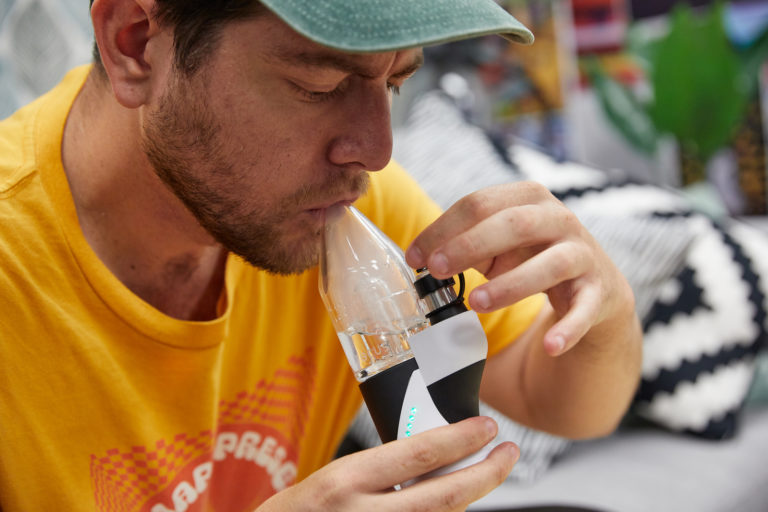A tolerance break — sometimes called a T-break — is a deliberate, temporary cessation of cannabis consumption for the purpose of resetting the body's tolerance to THC. Anyone who regularly consumes either medical or recreational cannabis, or both, will develop higher and higher tolerance to THC. This tolerance can be reduced by taking tolerance breaks.
 Photo by: Gina Coleman/Weedmaps
Photo by: Gina Coleman/WeedmapsImage lightbox

What is cannabis tolerance?
Tolerance is when the body becomes resistant to the effects of a substance or medication that is taken regularly. With repeated consumption, more of the substance is needed to achieve the original, desired effect. Like many other drugs and medicines, THC is consumed on a regular basis.
Tolerance is a very complex phenomenon and scientists don't fully understand the adaptations happening in our bodies when we experience it. However, brain imaging studies of people who use cannabis regularly have shown that chronic cannabis/THC use causes a decrease in the number of THC receptors in the brain.
The body's natural system that interacts with cannabis — our endocannabinoid system (ECS) — is a very dynamic and responsive system. It's no surprise that the ECS senses when it is being overwhelmed by THC and compensates by becoming less sensitive. As a result, more THC (in the form of more frequent use or higher potency cannabis varieties) is required to achieve the same results you experienced when you first started consuming.

Image lightbox

While tolerance builds with continued regular use, research is inconclusive on how long it takes to develop. Animal studies have suggested that female rodents develop tolerance more rapidly than males, but this has been difficult to study in humans. The process is highly variable and depends on numerous factors such as consumption patterns, THC doses, routes of administration, and even genetic makeup. The universal standard is, if you notice that you need to increase the amount of cannabis you're using in order to feel its effects, you've built up a tolerance.
Is it bad to build up a tolerance?
No, tolerance isn't necessarily a bad thing. Many medical patients wish to derive the benefits of THC (pain relief, for instance), but they have a hard time dealing with THC's side effects of impairment and brain fog. Once a person develops a sufficient level of tolerance, it is possible to reap the medical benefits of cannabis in the absence of unwanted impairment. Anecdotally, patients have reported that when they are first starting out on cannabis therapy, they have success taking THC right before bed. By sleeping through the intoxication for a week or two, they are slowly able to incorporate small amounts of THC into their daytime routine, capturing medical benefits with minimal side effects.
What are the benefits of a tolerance break?
Tolerance breaks offer plentiful benefits with little effort. Moderating cannabis consumption by taking regular breaks is a good strategy for minimizing the risks of consuming too much THC.
In the ECS, THC activates CB1 receptors in the brain's reward pathway, which triggers neurological responses that increase the likelihood a person will use cannabis again. While technically there's nothing wrong with the fact that cannabis is a rewarding substance that makes people feel good, anything that creates the feeling of reward can be abused. Too much regular consumption can increase the risk of developing cannabis use disorder (CUD), and cannabinoid hyperemesis syndrome (CHS). A tolerance break mitigates the risk of developing these disorders by disrupting the body's physical dependence on THC.
Taking a tolerance break also increases the effectiveness of cannabis on the body once you resume consumption. This means you get a more potent high (or more symptom relief) from less weed, which means less money spent in the long run.
 Photo by: Gina Coleman/Weedmaps
Photo by: Gina Coleman/WeedmapsImage lightbox

What are the side effects of a tolerance break?
Chronic users of cannabis may experience some withdrawal symptoms when attempting a tolerance break. One study showed that nearly half of consumers report withdrawal symptoms when quitting after regular, long-time use. These symptoms are similar to nicotine withdrawal and include irritability, decreased appetite, depressed mood, restlessness, anxiety, and insomnia. These side effects are most likely to occur in highly dependent consumers, but cannabis withdrawal symptoms are typically mild and generally not disruptive.
For medical patients, the symptoms that are being treated with cannabis are likely to return during a period of cannabis abstinence. Temporarily switching to another medication, or using complementary and alternative therapies may be helpful during this time. Because medical patients are likely to be daily consumers of cannabis, they are particularly vulnerable to the risks of chronic cannabis use (such as hyperemesis). Managing tolerance is an important part of sustainable, long-term cannabis therapy.
How do I take a tolerance break?
To take a tolerance break, stop consuming cannabis for at least two days. Research demonstrates that CB1 receptor availability is diminished by chronic cannabis use. These receptors rapidly return to a cannabis-naive state after a mere 48 hours of abstinence. That's to say, your tolerance should be back to normal after holding off from consuming for two days.
Some people may find this difficult to do because they have come to rely on cannabis to make their daily lives more manageable or enjoyable. While cutting back the frequency or amount you consume (exercising moderation) is never a bad thing, it's different than going cold-turkey and taking a true tolerance break to reset the body's ECS. Some people may find it helpful to taper down their use over a period of time before taking a true T-break for a few days.
Those who consume cannabis a few times per day may benefit from longer tolerance breaks of two weeks or even a month. However, the length of your tolerance break is entirely up to you. Determine what you want out of a tolerance break, give it a try, and see how your body feels. Everyone's body interacts with cannabis and THC differently, and there's no one-size-fits-all for tolerance breaks.
 Photo by: Gina Coleman/Weedmaps
Photo by: Gina Coleman/WeedmapsImage lightbox

Some consumers choose to take a tolerance break by replacing THC with CBD. Anecdotally, CBD seems to help mitigate the withdrawal symptoms that may occur with a tolerance break. Research in mice backs this up but human studies are needed.
How often should I take a tolerance break?
Tolerance breaks have not been rigorously studied by doctors or scientists. However, some cannabis-centric physicians and patient advocacy groups have suggested that taking a 48-hour break every 30 days is a good strategy for managing tolerance and preventing physical dependence.
Whether you are using cannabis to manage a chronic health condition or simply enjoy having it as a part of your regular routine, there are good reasons to monitor and manage your intake to keep your endocannabinoid system functioning at its best.
If you decide that it's time for a tolerance break, it might be helpful to let your friends and loved ones know. Ask your friends to support you and, with their help, avoid situations that may challenge your commitment to a tolerance reset.
Major contributions from Dr. Adie Rae.

